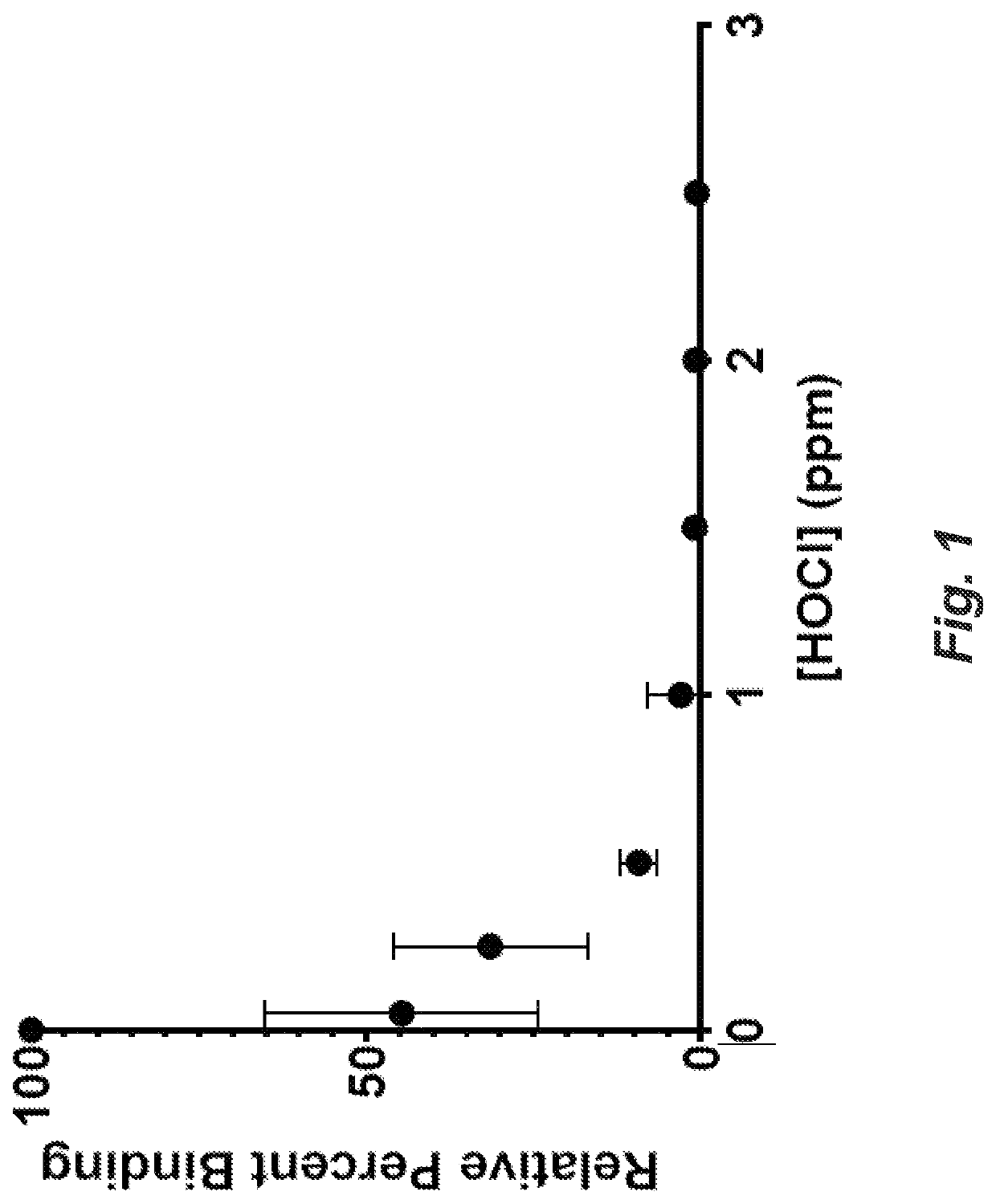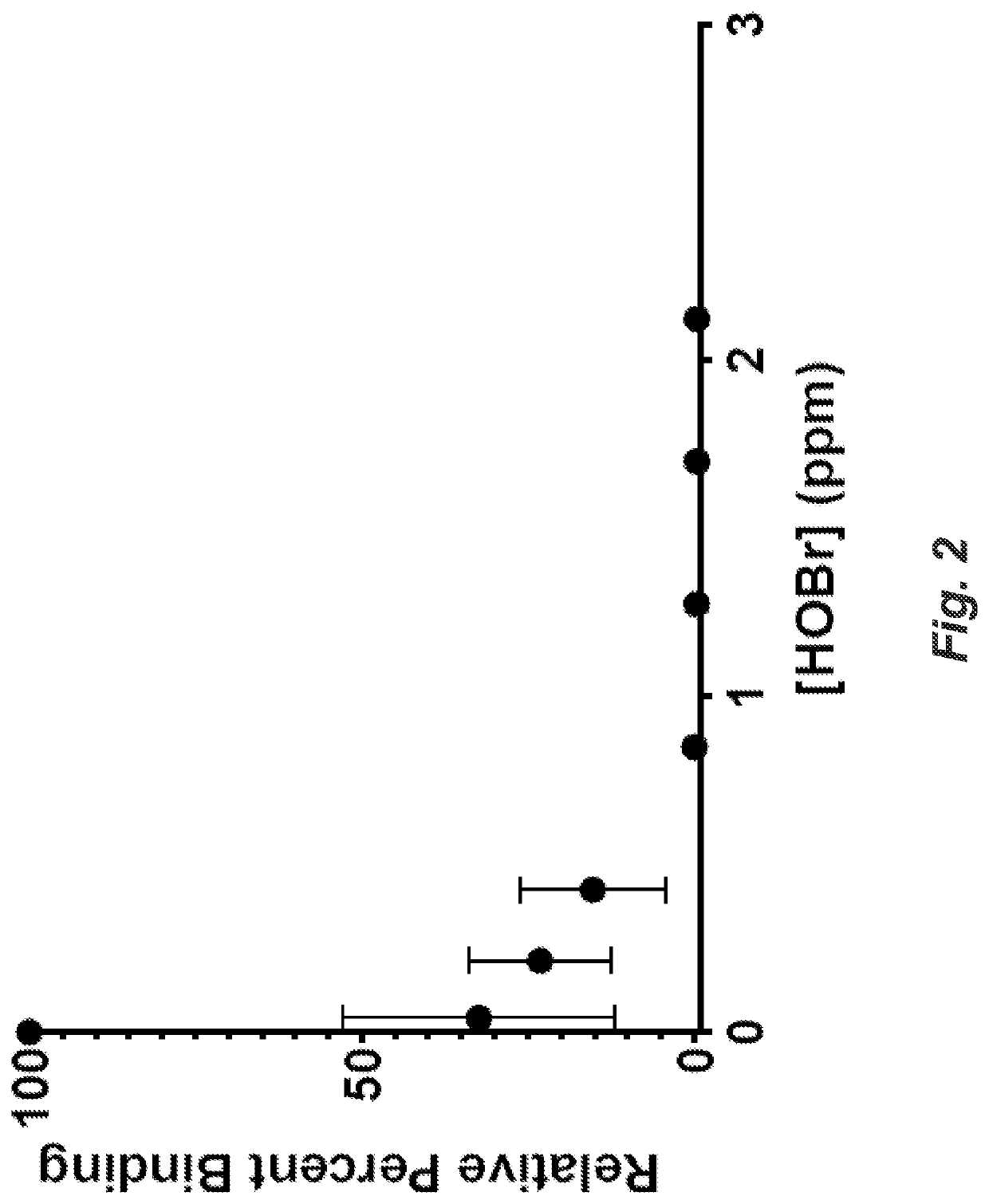Hypohalous acids for treating inflammatory diseases and inhibiting growth of malignancies
- Summary
- Abstract
- Description
- Claims
- Application Information
AI Technical Summary
Benefits of technology
Problems solved by technology
Method used
Image
Examples
example 1
Preparation of Authentic Pure and Stable Hypochlorous Acid and Hypobromous Acid
[0073]A hypochlorous acid (HOCl) composition useful in the methods of the invention, BrioHOCl™, was supplied by Briotech Inc., Woodinville, Wash. Briefly, HOCl results from electrolysis of an aqueous solution of sodium chloride so as to provide at the anode conditions that attract and stabilize reaction products that form HOCl. The end-product is a solution with a range of pH upon packaging and storage of 3.8-4.5 at warehouse environmental temperatures (3.5° C. to 35° C.), an oxidative reduction potential (ORP) ORP of +1100 mV, a salt (NaCl) concentration of either 0.85% to 2% by weight, and preferably 0.85% by weight, and a free chlorine concentration of preferentially 250-300 mg / L at the time of production. No adjustments are ever made to this HOCl solution by the addition of buffers, metal ions, organic heterocyclic halogen stabilizers or pH modifiers of any sort, at any level. Representative methods t...
example 2
Inhibition of IL-6 Reactivity with Specific Antibodies by Exposure to Authentic Pure HOCl or HOBr
[0075]An ELISA assay (Fisher Scientific) was used to detect binding changes between IL6 and anti-IL6 antibody binding in the presence of HOCl or HOBr. Anti-human IL6 antibody was immobilized to a polystyrene 96 well plate as the capture antibody. IL-6 was exposed to various concentrations of HOCl or HOBr for 5 minutes. The active halogen was quenched before incubation with the coated plate wells. A second anti-human IL6 antibody was introduced to the coated wells and served as a detector to an enzyme-mediated chromophore indicator system. At HOCl concentrations >2 ppm there was no detectable binding to the capture antibody. At >2 ppm in the presence of HOBr, binding was also undetectable, as shown in FIG. 2.
[0076]The inhibition of IL-6 reactivity by exposure to HOCl is illustrated in FIG. 1. The results demonstrate that exposure of IL-6 to HOCl or HOBr solutions results in rapid modifica...
example 3
Inhibition of Cell Receptor Binding by IL-6 after Exposure to Pure HOCl
[0077]An IL-6 bioassay (Promega) was used to determine the effect of HOCl on IL-6 binding to human cells triggering a change in luminescence. IL-6 was incubated with various concentrations of HOCl and quenched, before addition to the receptor-expressing human cells. Binding of the cytokine was measured by luminescence. At all concentrations tested, HOCl-treated IL-6 exhibited significantly reduced luminescence. The results demonstrate that exposure of IL-6 to HOCl results in complete inhibition of the capacity of the cytokine to initiate the transmembrane signaling necessary for triggering intracellular responses.
PUM
 Login to View More
Login to View More Abstract
Description
Claims
Application Information
 Login to View More
Login to View More - R&D Engineer
- R&D Manager
- IP Professional
- Industry Leading Data Capabilities
- Powerful AI technology
- Patent DNA Extraction
Browse by: Latest US Patents, China's latest patents, Technical Efficacy Thesaurus, Application Domain, Technology Topic, Popular Technical Reports.
© 2024 PatSnap. All rights reserved.Legal|Privacy policy|Modern Slavery Act Transparency Statement|Sitemap|About US| Contact US: help@patsnap.com









